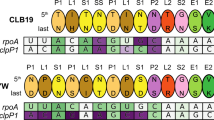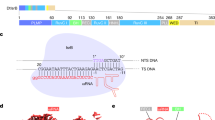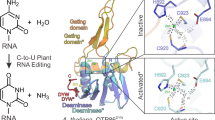Abstract
Pentatricopeptide repeat (PPR) proteins represent a large family of sequence-specific RNA-binding proteins that are involved in multiple aspects of RNA metabolism. PPR proteins, which are found in exceptionally large numbers in the mitochondria and chloroplasts of terrestrial plants1,2,3,4,5, recognize single-stranded RNA (ssRNA) in a modular fashion6,7,8. The maize chloroplast protein PPR10 binds to two similar RNA sequences from the ATPI–ATPH and PSAJ–RPL33 intergenic regions, referred to as ATPH and PSAJ, respectively9,10. By protecting the target RNA elements from 5′ or 3′ exonucleases, PPR10 defines the corresponding 5′ and 3′ messenger RNA termini9,10,11. Despite rigorous functional characterizations, the structural basis of sequence-specific ssRNA recognition by PPR proteins remains to be elucidated. Here we report the crystal structures of PPR10 in RNA-free and RNA-bound states at resolutions of 2.85 and 2.45 Å, respectively. In the absence of RNA binding, the nineteen repeats of PPR10 are assembled into a right-handed superhelical spiral. PPR10 forms an antiparallel, intertwined homodimer and exhibits considerable conformational changes upon binding to its target ssRNA, an 18-nucleotide PSAJ element. Six nucleotides of PSAJ are specifically recognized by six corresponding PPR10 repeats following the predicted code. The molecular basis for the specific and modular recognition of RNA bases A, G and U is revealed. The structural elucidation of RNA recognition by PPR proteins provides an important framework for potential biotechnological applications of PPR proteins in RNA-related research areas.
This is a preview of subscription content, access via your institution
Access options
Subscribe to this journal
Receive 51 print issues and online access
$199.00 per year
only $3.90 per issue
Buy this article
- Purchase on Springer Link
- Instant access to full article PDF
Prices may be subject to local taxes which are calculated during checkout




Similar content being viewed by others
References
Small, I. D. & Peeters, N. The PPR motif — a TPR-related motif prevalent in plant organellar proteins. Trends Biochem. Sci. 25, 45–47 (2000)
Nakamura, T., Yagi, Y. & Kobayashi, K. Mechanistic insight into pentatricopeptide repeat proteins as sequence-specific RNA-binding proteins for organellar RNAs in plants. Plant Cell Physiol. 53, 1171–1179 (2012)
Schmitz-Linneweber, C. & Small, I. Pentatricopeptide repeat proteins: a socket set for organelle gene expression. Trends Plant Sci. 13, 663–670 (2008)
Fujii, S. & Small, I. The evolution of RNA editing and pentatricopeptide repeat genes. New Phytol. 191, 37–47 (2011)
Kotera, E., Tasaka, M. & Shikanai, T. A pentatricopeptide repeat protein is essential for RNA editing in chloroplasts. Nature 433, 326–330 (2005)
Barkan, A. et al. A combinatorial amino acid code for RNA recognition by pentatricopeptide repeat proteins. PLoS Genet. 8, e1002910 (2012)
Yagi, Y., Hayashi, S., Kobayashi, K., Hirayama, T. & Nakamura, T. Elucidation of the RNA recognition code for pentatricopeptide repeat proteins involved in organelle RNA editing in plants. PLoS ONE 8, e57286 (2013)
Yagi, Y. et al. Pentatricopeptide repeat proteins involved in plant organellar RNA editing. RNA Biol. 10, 1236–1242 (2013)
Pfalz, J., Bayraktar, O. A., Prikryl, J. & Barkan, A. Site-specific binding of a PPR protein defines and stabilizes 5′ and 3′ mRNA termini in chloroplasts. EMBO J. 28, 2042–2052 (2009)
Prikryl, J., Rojas, M., Schuster, G. & Barkan, A. Mechanism of RNA stabilization and translational activation by a pentatricopeptide repeat protein. Proc. Natl Acad. Sci. USA 108, 415–420 (2011)
Zhelyazkova, P. et al. Protein-mediated protection as the predominant mechanism for defining processed mRNA termini in land plant chloroplasts. Nucleic Acids Res. 40, 3092–3105 (2012)
Lurin, C. et al. Genome-wide analysis of Arabidopsis pentatricopeptide repeat proteins reveals their essential role in organelle biogenesis. Plant Cell 16, 2089–2103 (2004)
Cushing, D. A., Forsthoefel, N. R., Gestaut, D. R. & Vernon, D. M. Arabidopsis emb175 and other ppr knockout mutants reveal essential roles for pentatricopeptide repeat (PPR) proteins in plant embryogenesis. Planta 221, 424–436 (2005)
Khrouchtchova, A., Monde, R. A. & Barkan, A. A short PPR protein required for the splicing of specific group II introns in angiosperm chloroplasts. RNA 18, 1197–1209 (2012)
Bentolila, S., Alfonso, A. A. & Hanson, M. R. A pentatricopeptide repeat-containing gene restores fertility to cytoplasmic male-sterile plants. Proc. Natl Acad. Sci. USA 99, 10887–10892 (2002)
Desloire, S. et al. Identification of the fertility restoration locus, Rfo, in radish, as a member of the pentatricopeptide-repeat protein family. EMBO Rep. 4, 588–594 (2003)
Wang, Z. et al. Cytoplasmic male sterility of rice with boro II cytoplasm is caused by a cytotoxic peptide and is restored by two related PPR motif genes via distinct modes of mRNA silencing. Plant Cell 18, 676–687 (2006)
Chase, C. D. Cytoplasmic male sterility: a window to the world of plant mitochondrial–nuclear interactions. Trends Genet. 23, 81–90 (2007)
Hu, J. et al. The rice pentatricopeptide repeat protein RF5 restores fertility in Hong-Lian cytoplasmic male-sterile lines via a complex with the glycine-rich protein GRP162. Plant Cell 24, 109–122 (2012)
Mootha, V. K. et al. Identification of a gene causing human cytochrome c oxidase deficiency by integrative genomics. Proc. Natl Acad. Sci. USA 100, 605–610 (2003)
Ruzzenente, B. et al. LRPPRC is necessary for polyadenylation and coordination of translation of mitochondrial mRNAs. EMBO J. 31, 443–456 (2012)
Howard, M. J., Lim, W. H., Fierke, C. A. & Koutmos, M. Mitochondrial ribonuclease P structure provides insight into the evolution of catalytic strategies for precursor-tRNA 5′ processing. Proc. Natl Acad. Sci. USA 109, 16149–16154 (2012)
Ringel, R. et al. Structure of human mitochondrial RNA polymerase. Nature 478, 269–273 (2011)
Wang, X., McLachlan, J., Zamore, P. D. & Hall, T. M. Modular recognition of RNA by a human pumilio-homology domain. Cell 110, 501–512 (2002)
Grove, T. Z., Cortajarena, A. L. & Regan, L. Ligand binding by repeat proteins: natural and designed. Curr. Opin. Struct. Biol. 18, 507–515 (2008)
Deng, D. et al. Structural basis for sequence-specific recognition of DNA by TAL effectors. Science 335, 720–723 (2012)
Gao, H., Wu, X., Chai, J. & Han, Z. Crystal structure of a TALE protein reveals an extended N-terminal DNA binding region. Cell Res. 22, 1716–1720 (2012)
Kobayashi, K. et al. Identification and characterization of the RNA binding surface of the pentatricopeptide repeat protein. Nucleic Acids Res. 40, 2712–2723 (2012)
Filipovska, A. & Rackham, O. Modular recognition of nucleic acids by PUF, TALE and PPR proteins. Mol. Biosyst. 8, 699–708 (2012)
DeLano, W. L. The PyMOL Molecular Graphics System. http://www.pymol.org (2002)
Otwinowski, Z. & Minor, W. Processing of X-ray diffraction data collected in oscillation mode. Methods Enzymol. 276, 307–326 (1997)
Collaborative Computational Project, 4. The CCP4 suite: programs for protein crystallography. Acta Crystallogr. D 50, 760–763 (1994)
Schneider, T. R. & Sheldrick, G. M. Substructure solution with SHELXD. Acta Crystallogr. D 58, 1772–1779 (2002)
Emsley, P. & Cowtan, K. Coot: model-building tools for molecular graphics. Acta Crystallogr. D 60, 2126–2132 (2004)
McCoy, A. J. et al. Phaser crystallographic software. J. Appl. Crystallogr. 40, 658–674 (2007)
Adams, P. D. et al. PHENIX: building new software for automated crystallographic structure determination. Acta Crystallogr. D 58, 1948–1954 (2002)
Schuck, P. On the analysis of protein self-association by sedimentation velocity analytical ultracentrifugation. Anal. Biochem. 320, 104–124 (2003)
Acknowledgements
We thank X. Yu and Y. Chen at the Institute of Biophysics, Chinese Academy of Sciences, for technical support. We thank K. Hasegawa and T. Kumasaka at the SPring-8 beamline BL41XU for on-site assistance. This work was supported by funds from the Ministry of Science and Technology (grant number 2011CB910501 for N.Y.), and Projects 91017011 (N.Y.), 31070644 (N.Y.), 31021002 (Y.S., N.Y., J.W.) and 31200567 (P.Y.) of the National Natural Science Foundation of China. The research of N.Y. was supported in part by an International Early Career Scientist grant from the Howard Hughes Medical Institute.
Author information
Authors and Affiliations
Contributions
P.Y., Q.L., J.-K.Z., Y.S. and N.Y. designed all experiments. P.Y., Q.L., C.Y., Y.L., J.L., F.Y., Z.W., J.L., J.H., H.-W.W., J.W. and N.Y. performed the experiments. All authors analysed the data and contributed to manuscript preparation. N.Y. wrote the manuscript.
Corresponding author
Ethics declarations
Competing interests
The authors declare no competing financial interests.
Extended data figures and tables
Extended Data Figure 1 Sequence alignment of the 19 repeats of PPR10.
a, PPR10 from maize specifically recognizes two RNA elements. The cartoon above illustrates the predicted domain organization of PPR10. 1 and 19 refer to the repeat numbers. CTP, chloroplast transit peptide. The blue brick with ‘?’ represents a fragment of approximately 30 amino acids whose function remains to be characterized. The minimal RNA elements of PSAJ and ATPH that are targeted by PPR10 are shown below the cartoon. b, Sequence alignment of 19 repeats in PPR10. The secondary structural elements of a typical PPR motif are shown above. The residues at the 2nd, 5th and 35th positions which were predicted to be the molecular determinants for RNA-binding specificity are highlighted in magenta. The RNA sequences that can be recognized by PPR10 are listed on the right, 5′ to 3′ from top to bottom. The nucleotides which are recognized by PPR10 in a modular fashion in the PSAJ–PPR10 structure are shaded grey. c, The three numbering systems for a PPR motif. 1 is being used by Lurin et al.12, Barkan et al.6 and others; 2 is adopted by the Pfam database and being used by Kobayashi et al.28, Yagi et al.7 and others; and 3 is our proposed, structure-based numbering system. The residues that are predicted to specifically recognize RNA are coloured magenta.
Extended Data Figure 2 AUC-SE of PPR10 (residues 37–786, C256S/C279S/C430S/C449S) in the absence or presence of the target RNA elements.
The molar concentrations of PPR10 are indicated above each panel. PPR10 and the RNA oligonucleotides were mixed at a stoichiometric ratio of approximately 1:1.5. Details of the experiments are described in Methods.
Extended Data Figure 3 The two protomers of the RNA-bound PPR10 dimer exhibit similar conformations.
a, The two protomers can be superimposed with a root-mean-squared deviation of 1.31 Å over 629 Cα atoms. b, c, The two ssRNA segments are coordinated by the PPR10 dimer similarly. The 5′ and 3′ segments of the bound PSAJ RNA are separately coordinated by the N-terminal repeats of one protomer (b), and the C-terminal repeats of the other protomer (c). Stereo-views are shown for all panels.
Extended Data Figure 4 Electron density maps for a bound ssRNA segment.
a, The 2Fo – Fc electron density for one segment of the bound PSAJ RNA. The electron density, contoured at 1σ and coloured blue, is displayed in stereo. b, c, The anomalous signals for bromine in the structures where the highlighted nucleotides were substituted with 5-bromouracil (5-BrU). The anomalous signals, shown in magenta mesh, are contoured at 5σ.
Extended Data Figure 5 Coordination of the bound ssRNA by PPR10.
a, The 5′ and 3′ portions of the PSAJ RNA element are separately bound by the N-terminal and C-terminal repeats of the two PPR10 protomers. Shown here is a close-up view of the binding of PSAJ by one end of the PPR10 dimer. b, The nucleotides U5–A10, which form a U-turn in the ssRNA, are uncoordinated in the cavity of the PPR10 dimer. The two protomers of PPR10 are shown in semi-transparent surface contour. c, The RNA backbone is coordinated by polar or charged residues through hydrogen bonds. The hydrogen bonds are represented by red dotted lines. The two protomers of PPR10 are coloured light purple and grey.
Extended Data Figure 6 Mutational analysis of PPR10 residues that may be important for PSAJ.
a, EMSA analysis of the interaction between PPR10 (residues 37–786, C256S/C279S/C430S/C449S) and PSAJ (5′-GUAUUCUUUAAUUAUUUC-3′). PPR10 was added with increasing concentrations of 0, 2, 4, 8, 16, 31, 63, 125, 250, 500, 1,000 nM in lanes 1–11 with approximately 40 pM 32P-labelled PSAJ in each lane. b, Mutational analysis of the 5th residues of the indicated PPR motifs. The indicated point mutations were introduced to PPR10 (residues 37–786, C256S/C279S/C430S/C449S). c, Examination of the 2nd residues in repeats 3 and 5. d, Examination of the 35th residue of repeat 6. Note that the side group of Asp 314 is hydrogen bonded to the side chain of Asn 284, the 5th residue of repeat 6. The same structural feature is also seen in repeat 4 (Fig. 3b).
Extended Data Figure 7 The predicted coordination of base C by an Asn at the 5th position of a PPR motif.
Left, the coordination of base U by Asn observed in the structure. Right, the coordination of base C by Asn at the 5th position of a PPR motif modelled on the basis of the structure shown on the left.
Extended Data Figure 8 Comparison of ssRNA coordination by PUF and PPR proteins.
a, The structure of the human PUF protein PUM1 (also known as HSPUM) bound to the RNA element NRE1-19 (PDB accession code, 1M8W)24. The PUF repeats constitute an arc with 8-nt ssRNA bound to the concave side. Notably, the orientations of the bound RNA and the protein are antiparallel, namely the 5′ end is close to the C terminus of PUF. b, The structure of a PUF repeat. One canonical PUF repeat contains three helices, of which a short helix precedes a helical hairpin. c, Representative recognition of the RNA bases G, U, A by PUF repeats as seen in the structure of PUM1 bound to NRE1-19. The amino acids are labelled by the repeat number (r5, r6, r7, r8) followed by its one-letter code and position on the 2nd helix within a PUF repeat (S3, N4, E8, and so on). The same scheme applies to d. d, The coordination of RNA bases G, U, A by PPR10. It is noteworthy that PUF and PPR proteins share several common features for RNA binding: (1) the ssRNA elements are coordinated by the helices on the inner layer; and (2) the base is sandwiched mostly by hydrophobic residues or Arg. Yet the differences are evident between the two families of repeat proteins. As seen in c, the RNA base is usually coordinated by two residues that are located at the 4th and the 7th positions on helix 2 within a PUF repeat. By contrast, the base is mainly coordinated by the 5th residue of a PPR motif. The 35th residue, the last residue of a PPR motif that is located at a loop region preceding the next PPR motif, also contributes to base recognition.
Rights and permissions
About this article
Cite this article
Yin, P., Li, Q., Yan, C. et al. Structural basis for the modular recognition of single-stranded RNA by PPR proteins. Nature 504, 168–171 (2013). https://doi.org/10.1038/nature12651
Received:
Accepted:
Published:
Issue Date:
DOI: https://doi.org/10.1038/nature12651
This article is cited by
-
Differential adaptive RNA editing signals between insects and plants revealed by a new measurement termed haplotype diversity
Biology Direct (2023)
-
A mitochondrial pentatricopeptide repeat protein enhances cold tolerance by modulating mitochondrial superoxide in rice
Nature Communications (2023)
-
The PPR-Domain Protein SOAR1 Regulates Salt Tolerance in Rice
Rice (2022)
-
U-to-C RNA editing by synthetic PPR-DYW proteins in bacteria and human culture cells
Communications Biology (2022)
-
DYW domain structures imply an unusual regulation principle in plant organellar RNA editing catalysis
Nature Catalysis (2021)
Comments
By submitting a comment you agree to abide by our Terms and Community Guidelines. If you find something abusive or that does not comply with our terms or guidelines please flag it as inappropriate.



